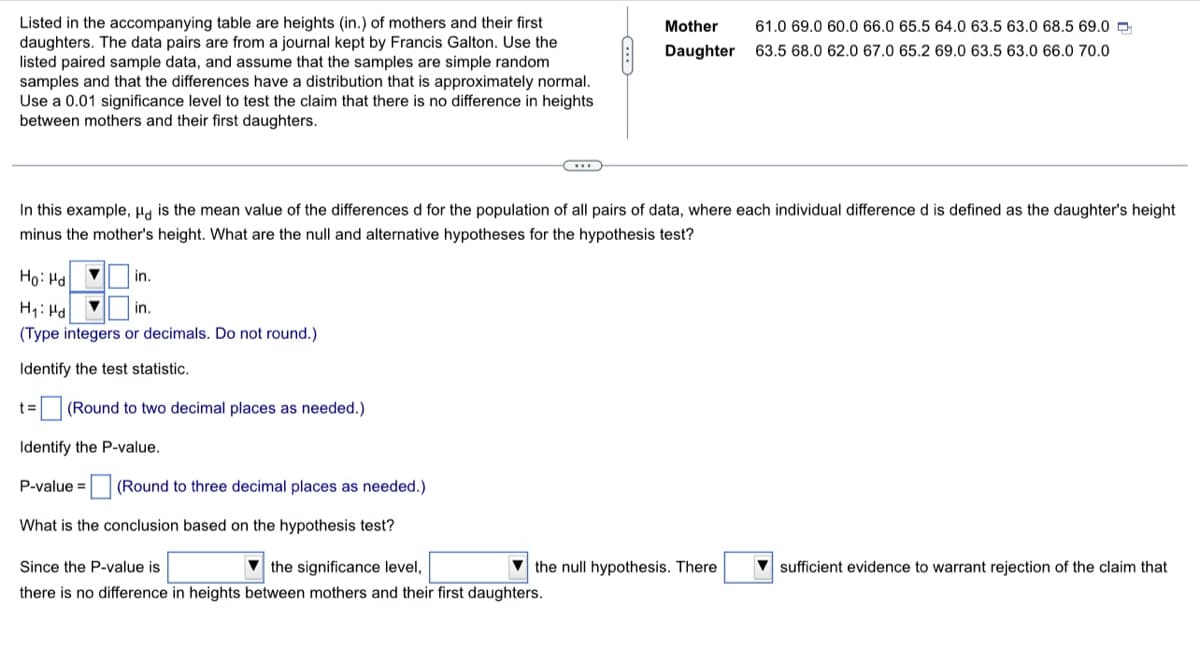paired sample data, and assume that the samples are simple random es and that the differences have a distribution that is approximately normal. 0.01 significance level to test the claim that there is no difference in heights en mothers and their first daughters. example, Hg is the mean value of the differences d for the population of all pairs of data, where each individual difference d is defined as th the mother's height. What are the null and alternative hypotheses for the hypothesis test? in. in. integers or decimals. Do not round.) y the test statistic. (Round to two decimal places as needed.) y the P-value. = (Round to three decimal places as needed.) is the conclusion based on the hypothesis test? the P-value is V the significance level, the null hypothesis. There sufficient evidence to warrant rejectic
paired sample data, and assume that the samples are simple random es and that the differences have a distribution that is approximately normal. 0.01 significance level to test the claim that there is no difference in heights en mothers and their first daughters. example, Hg is the mean value of the differences d for the population of all pairs of data, where each individual difference d is defined as th the mother's height. What are the null and alternative hypotheses for the hypothesis test? in. in. integers or decimals. Do not round.) y the test statistic. (Round to two decimal places as needed.) y the P-value. = (Round to three decimal places as needed.) is the conclusion based on the hypothesis test? the P-value is V the significance level, the null hypothesis. There sufficient evidence to warrant rejectic
Glencoe Algebra 1, Student Edition, 9780079039897, 0079039898, 2018
18th Edition
ISBN:9780079039897
Author:Carter
Publisher:Carter
Chapter10: Statistics
Section10.4: Distributions Of Data
Problem 19PFA
Related questions
Question

Transcribed Image Text:Listed in the accompanying table are heights (in.) of mothers and their first
daughters. The data pairs are from a journal kept by Francis Galton. Use the
listed paired sample data, and assume that the samples are simple random
samples and that the differences have a distribution that is approximately normal.
Use a 0.01 significance level to test the claim that there is no difference in heights
between mothers and their first daughters.
Mother
61.0 69.0 60.0 66.0 65.5 64.0 63.5 63.0 68.5 69.0 D
Daughter
63.5 68.0 62.0 67.0 65.2 69.0 63.5 63.0 66.0 70.0
In this example, Ha is the mean value of the differences d for the population of all pairs of data, where each individual difference d is defined as the daughter's height
minus the mother's height. What are the null and alternative hypotheses for the hypothesis test?
Ho: Hd
in.
H1: Hd
in.
(Type integers or decimals. Do not round.)
Identify the test statistic.
t= (Round to two decimal places as needed.)
Identify the P-value.
P-value =
(Round to three decimal places as needed.)
What is the conclusion based on the hypothesis test?
Since the P-value is
V the significance level,
the null hypothesis. There
V sufficient evidence to warrant rejection of the claim that
there is no difference in heights between mothers and their first daughters.
Expert Solution
This question has been solved!
Explore an expertly crafted, step-by-step solution for a thorough understanding of key concepts.
This is a popular solution!
Trending now
This is a popular solution!
Step by step
Solved in 3 steps with 2 images

Recommended textbooks for you

Glencoe Algebra 1, Student Edition, 9780079039897…
Algebra
ISBN:
9780079039897
Author:
Carter
Publisher:
McGraw Hill

Glencoe Algebra 1, Student Edition, 9780079039897…
Algebra
ISBN:
9780079039897
Author:
Carter
Publisher:
McGraw Hill